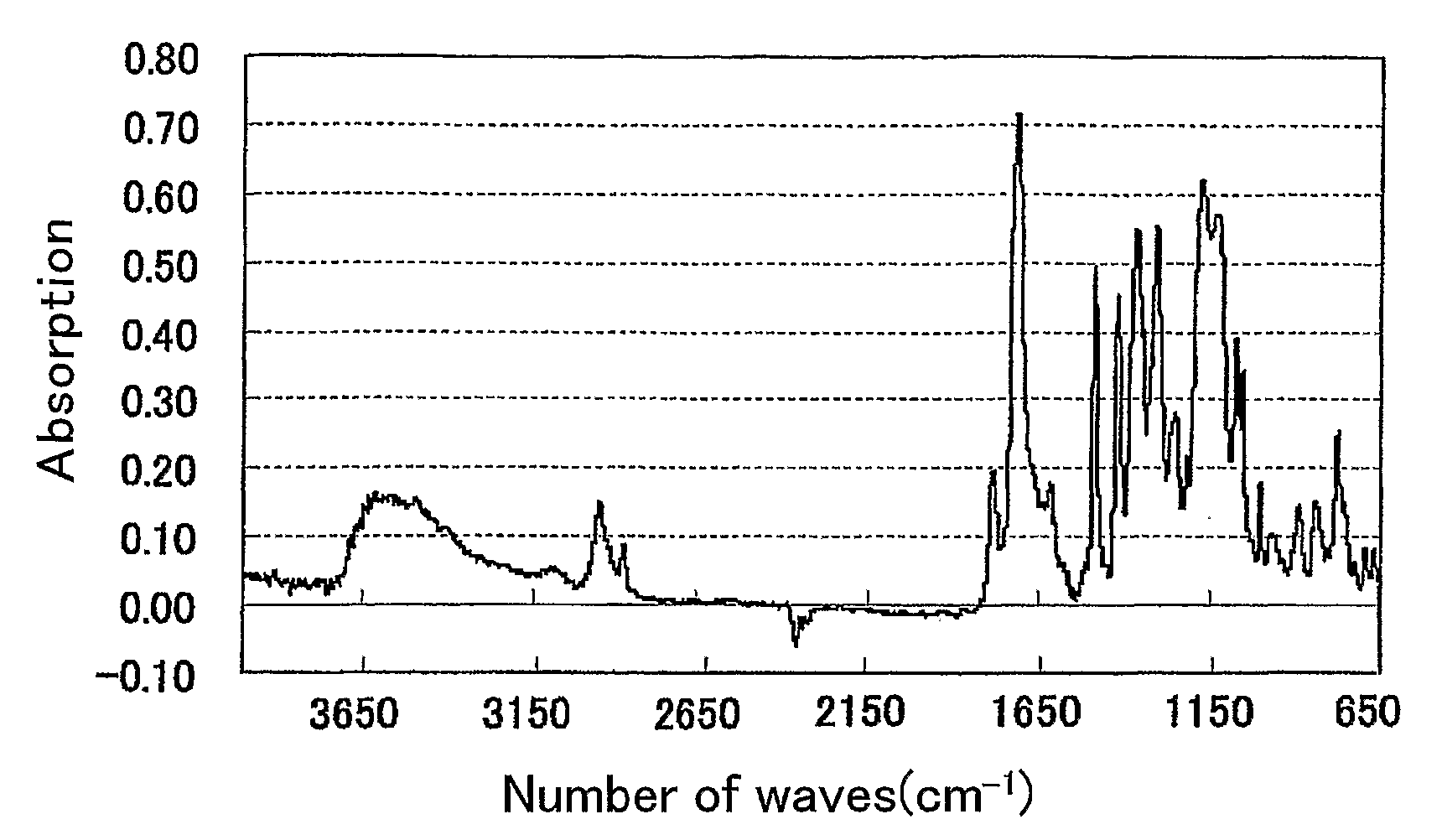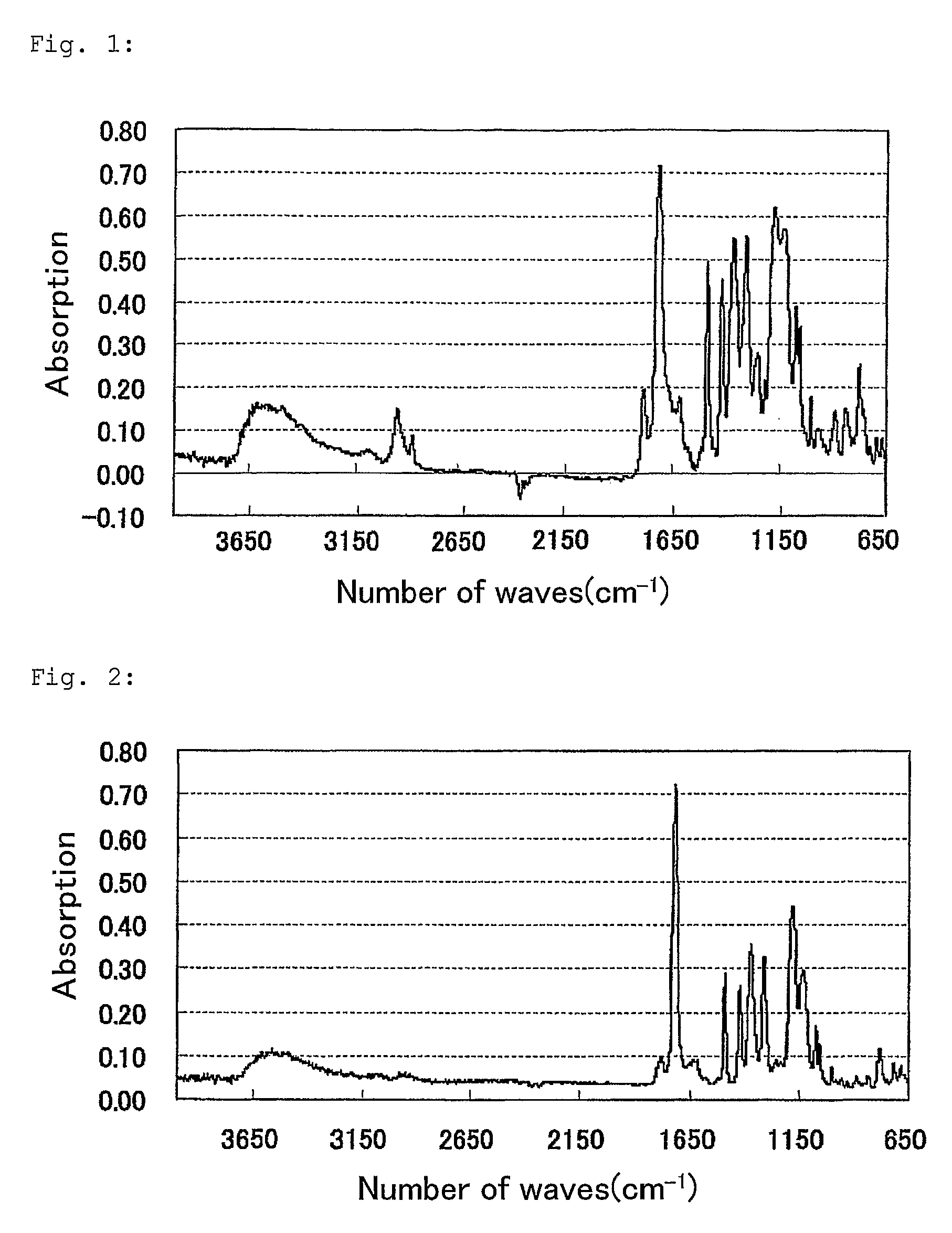Polymer, Method For Producing the Polymer, Optical Film, and Image Display Device
a technology of optical film and polymer, which is applied in the direction of photomechanical equipment, instruments, natural mineral layered products, etc., can solve the problems of poor heat resistance of plastic substrates, reduced conductivity and gas-barrier properties of layers, and increased cost, etc., to achieve the effect of improving the properties of plastic substrates
- Summary
- Abstract
- Description
- Claims
- Application Information
AI Technical Summary
Benefits of technology
Problems solved by technology
Method used
Image
Examples
example 1
1. Production of Films
(1) Production of Film P-1:
[0086]32 g of 2,2′-bis(trifluoromethyl)-4,4′-diaminobiphenyl was put into a reactor equipped with a thermometer, a stirrer and a nitrogen-introducing duct, and this was dissolved in 230 g of N-methyl-2-pyrrolidone. Then, 25 g of bicyclo[2.2.2]octane-2,3,5,6-tetracarboxylic acid was gradually added to it at 15° C. This was reacted at 30° C. for 1 hour, then at 70° C. for 1 hour and further at 100° C. for 1 hour, and this gave a transparent solution. Next, as additives, 6.2 g of triphenyl phosphite and 16 g of pyridine were gradually and dropwise added to it, and this was stirred at 100° C. for 0.5 hours, then at 130° C. for 0.5 hours, at 150° C. for 0.5 hours and at 170° C. for 5 hours. Next, the solution was kept cooled, and then reprecipitated in a mixed solution of 2 liters of methanol and 2 liters of water to obtain a polymer. This was filtered, the deposit was dried and again dissolved in N,N-dimethylacetamide. Using a film applic...
example 2
Production of Stretched Films
1. Monoaxial Stretching
[0099]For confirming the fact that the stretched polymer of the invention shows extremely lowered thermal expansiveness, the polymer of the invention was stretched.
[0100]A film sample (2.0 cm×7.0 cm piece) is prepared, and monoaxially stretched at a pulling rate of 200 mm / min, using a tensilon (Orientec's Tensilon RTC-1210A). Three samples are tried in one test, and their data are averaged. (The chuck-to-chuck distance is 5 cm, and the draw ratio is 1.3 times.)
[0101]The polymer P-1 was dissolved in N,N-dimethylacetamide in a ratio of 20% by mass to prepare a dope. This was cast on a glass plate, using a doctor blade, and dried at 80° C. Before completely dried, this was peeled from the glass plate, cut into a piece having a size of 20 mm×70 mm, and stretched with a tensilon. The stretching condition was as follows: The resin temperature was 250° C., the pulling rate was 200 mm / min, the chuck-to-chuck distance was 50 mm, and the dra...
example 3
Formation of Gas-Barrier Layer and Transparent Electrode Layer
1. Formation of Gas-Barrier Layer
[0105]A target of Si was sputtered onto both surfaces of the optical film samples P-1, P-2, P-21 and P-22 fabricated in the above, according to a DC magnetron sputtering process under a vacuum of 500 Pa in an Ar atmosphere with oxygen being introduced into the chamber. The pressure was 0.1 Pa and the output power was 5 kW. A gas-barrier layer was thus formed, and it had a thickness of 60 nm. The water vapor permeation through the optical film samples with a gas-barrier layer formed on both surfaces thereof was at most 0.1 g / m2·day, measured at 40° C. and at a relative humidity of 90%; and the oxygen permeation through them was at most 0.1 ml / m2 ·day, measured at 40° C. and at a relative humidity of 90%.
2. Formation of Transparent Conductive Layer
[0106]While the gas-barrier layer-coated optical film samples were heated at 300° C., a target of ITO (In2O3, 95 mas. %; SnO2, 5 mas. %) was sputt...
PUM
| Property | Measurement | Unit |
|---|---|---|
| Thickness | aaaaa | aaaaa |
| Thickness | aaaaa | aaaaa |
| Glass transition temperature | aaaaa | aaaaa |
Abstract
Description
Claims
Application Information
 Login to View More
Login to View More - R&D
- Intellectual Property
- Life Sciences
- Materials
- Tech Scout
- Unparalleled Data Quality
- Higher Quality Content
- 60% Fewer Hallucinations
Browse by: Latest US Patents, China's latest patents, Technical Efficacy Thesaurus, Application Domain, Technology Topic, Popular Technical Reports.
© 2025 PatSnap. All rights reserved.Legal|Privacy policy|Modern Slavery Act Transparency Statement|Sitemap|About US| Contact US: help@patsnap.com



